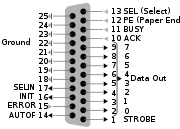
LPT
Encyclopedia

Parallel port
A parallel port is a type of interface found on computers for connecting various peripherals. In computing, a parallel port is a parallel communication physical interface. It is also known as a printer port or Centronics port...
interface on IBM PC-compatible computer
Computer
A computer is a programmable machine designed to sequentially and automatically carry out a sequence of arithmetic or logical operations. The particular sequence of operations can be changed readily, allowing the computer to solve more than one kind of problem...
s. It was designed to operate a text printer
Computer printer
In computing, a printer is a peripheral which produces a text or graphics of documents stored in electronic form, usually on physical print media such as paper or transparencies. Many printers are primarily used as local peripherals, and are attached by a printer cable or, in most new printers, a...
that used IBM
IBM
International Business Machines Corporation or IBM is an American multinational technology and consulting corporation headquartered in Armonk, New York, United States. IBM manufactures and sells computer hardware and software, and it offers infrastructure, hosting and consulting services in areas...
's 8-bit extended ASCII
Extended ASCII
The term extended ASCII describes eight-bit or larger character encodings that include the standard seven-bit ASCII characters as well as others...
character set. The name derives from the fact that "line printer
Line printer
The line printer is a form of high speed impact printer in which one line of type is printed at a time. They are mostly associated with the early days of computing, but the technology is still in use...
" was a common generic term at the time for any type of text printer. Graphical printers, along with a host of other devices, have been designed to communicate with the system. It was a de facto
De facto
De facto is a Latin expression that means "concerning fact." In law, it often means "in practice but not necessarily ordained by law" or "in practice or actuality, but not officially established." It is commonly used in contrast to de jure when referring to matters of law, governance, or...
industry standard for many years, and was finally standardized as IEEE 1284
IEEE 1284
IEEE 1284 is a standard that defines bi-directional parallel communications between computers and other devices.-History:In the 1970s, Centronics developed the now-familiar printer parallel port that soon became a de facto standard...
in the late 1990s. Today, the parallel port interface is seeing decreasing use because of the rise of Universal Serial Bus
Universal Serial Bus
USB is an industry standard developed in the mid-1990s that defines the cables, connectors and protocols used in a bus for connection, communication and power supply between computers and electronic devices....
(USB) and FireWire (IEEE 1394) devices; along with network printing using Ethernet
Ethernet
Ethernet is a family of computer networking technologies for local area networks commercially introduced in 1980. Standardized in IEEE 802.3, Ethernet has largely replaced competing wired LAN technologies....
.
History
Most PC-compatible systems in the 1980s and 1990s had one or two ports, with communication interfaces defined like this:- LPT1: I/O port 0x378, IRQ 7 (usually in monochrome graphics adapters, dedicated IO cards in color systems, or using a controller built into the mainboard)
- LPT2: I/O port 0x278, IRQ 5 (usually in serial port controller, or the stand-alone IBM Printer adapter)
Some systems also had an LPT3 port, but this was less-consistently defined, generally sharing the LPT1 interrupt despite having its own IO address (ie only one could be used at a time). In reality, computers rarely have more than one LPT port.
A wide variety of devices were eventually designed to operate on a parallel port. Most were uni-directional (one-way) devices, only meant to respond to information sent from the PC. However, some devices such as Zip drive
Zip drive
The Zip drive is a medium-capacity removable disk storage system that was introduced by Iomega in late 1994. Originally, Zip disks launched with capacities of 100 MB, but later versions increased this to first 250 MB and then 750 MB....
s were able to operate in bi-directional mode. Printers also eventually took up the bi-directional system, allowing various status report information to be sent.
In DOS
DOS
DOS, short for "Disk Operating System", is an acronym for several closely related operating systems that dominated the IBM PC compatible market between 1981 and 1995, or until about 2000 if one includes the partially DOS-based Microsoft Windows versions 95, 98, and Millennium Edition.Related...
, the parallel ports could be accessed directly on the command line. For example, the command "type c:\autoexec.bat > LPT1" would direct the contents of the autoexec.bat
AUTOEXEC.BAT
AUTOEXEC.BAT is a system file found originally on DOS-type operating systems. It is a plain-text batch file that is located in the root directory of the boot device...
file to the printer port. A PRN device was also available as an alias for LPT1. A special "print" command also existed to achieve the same effect. Microsoft Windows
Microsoft Windows
Microsoft Windows is a series of operating systems produced by Microsoft.Microsoft introduced an operating environment named Windows on November 20, 1985 as an add-on to MS-DOS in response to the growing interest in graphical user interfaces . Microsoft Windows came to dominate the world's personal...
still refers to the ports in this manner in many cases, though this is often fairly hidden. In the Linux
Linux
Linux is a Unix-like computer operating system assembled under the model of free and open source software development and distribution. The defining component of any Linux system is the Linux kernel, an operating system kernel first released October 5, 1991 by Linus Torvalds...
operating system the first LPT port is available via the filesystem as /dev/lp0.
Naming
PRN, along with CON, AUX and a few others are invalid file and directory names in DOS and Windows, even Windows XP. There is even a "ConconConcon
Con/con is a computer bug that appeared in the Windows 95 and Windows 98 operating systems. The name comes from the fact that referring to the file "C:\con\con" would crash these systems. This was a particular case of a more general bug, where the system failed to respond correctly to file paths...
" bug in Windows 95 and 98, which causes the computer to crash if the user types "C:\con\con", "C:\prn\prn" or "C:\aux\aux" in the Windows Explorer address bar. A patch to fix this bug has been released by Microsoft
Microsoft
Microsoft Corporation is an American public multinational corporation headquartered in Redmond, Washington, USA that develops, manufactures, licenses, and supports a wide range of products and services predominantly related to computing through its various product divisions...
, but newly installed Windows 95 and 98 operating systems will still have the bug.
Pinout
An LPT port has an 8-bit data bus and four pins for control output (Strobe, Linefeed, Initialize, and Select In), and five more for control input (ACK, Busy, Select, Error, and Paper Out). Its data transfer speed is at 12,000 kbit/s.Etymology
The original meaning of the "LPT" abbreviation was "Line Print Terminal". According to the Jargon FileJargon File
The Jargon File is a glossary of computer programmer slang. The original Jargon File was a collection of terms from technical cultures such as the MIT AI Lab, the Stanford AI Lab and others of the old ARPANET AI/LISP/PDP-10 communities, including Bolt, Beranek and Newman, Carnegie Mellon...
, a similar port naming convention was used on ITS
Incompatible Timesharing System
ITS, the Incompatible Timesharing System , was an early, revolutionary, and influential time-sharing operating system from MIT; it was developed principally by the Artificial Intelligence Laboratory at MIT, with some help from Project MAC.In addition to being technically influential ITS, the...
, DEC
Digital Equipment Corporation
Digital Equipment Corporation was a major American company in the computer industry and a leading vendor of computer systems, software and peripherals from the 1960s to the 1990s...
systems, and CP/M
CP/M
CP/M was a mass-market operating system created for Intel 8080/85 based microcomputers by Gary Kildall of Digital Research, Inc...
.
See also
- Device file
- COM
- Input/Output Base AddressInput/Output Base AddressIn the x86 architecture, an input/output base address is a base address of an I/O port. In other words, this is the first address of a range of consecutive I/O port addresses that device uses....
- IEEE 1284IEEE 1284IEEE 1284 is a standard that defines bi-directional parallel communications between computers and other devices.-History:In the 1970s, Centronics developed the now-familiar printer parallel port that soon became a de facto standard...
LPT connectors - Covox Speech ThingCovox Speech ThingThe Covox Speech Thing was an external audio device attached to the computer to output digital sound. It was composed of the most primitive 8-bit DAC using a resistor ladder and an analogue signal output, and plugged in to the printer port of the PC.The circuit was marketed around 1986 by Covox,...

